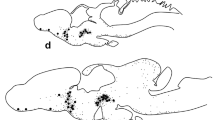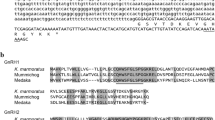Summary
Three polyclonal antisera raised in rabbits against the mammalian molecular form of gonadotropin-releasing hormone (GnRH) were tested in enzyme-linked immunosorbent assays for crossreactivity with naturally occurring GnRHs and with GnRH analogues. Antisera were then tested immunocytochemically in order (i) to identify amino acids essential for the binding of each antiserum, and (ii) to evaluate the specificity of the immunocytochemical reaction in brain sections from various species of cyclostomes, amphibians, reptiles, and birds. Antiserum GnRH 80/1, recognizing mainly a discontinuous determinant including the NH2- and COOH-termini, crossreacts with GnRHs the molecular bending of which enables the spatial approach of both terminal amino acid residues. Antiserum GnRH 80/2, by requiring the COOH-terminus for binding and not tolerating substitutions by aromatic amino acids in the middle region of the molecule, recognizes chicken I GnRH, however, not the salmon form. The use of this antiserum is appropriate in species synthesizing the mammalian and/or the chicken I form of GnRH. GnRH antiserum 81/1 is specific mostly for mammalian GnRH. The results obtained by ELISAs are confirmed by immunocytochemical studies. A comparison between the results obtained in ELISA and in immunocytochemistry involving mammalian-, chicken I-, chicken II-, salmon-, and lamprey-directed GnRH antisera resulted in the following conclusions: (1) An antiserum recognizing the discontinuous antigen determinant including both NH2- and COOH-termini may be reactive in most vertebrate brain sections thus being appropriate for phylogenetically directed immunocytochemical studies. (2) Moreover, this discontinuous determinant seems to be immunocytochemically reactive in all parts of the neurons in the GnRH system, whereas, in some species, determinants located in the middle region of the molecule(s) tend to become reactive only during the axonal transport. (3) A crossreaction between tissue-bound antigen and antibodies recognizing the above cited discontinuous determinant indicates an appropriate bending of the molecule even in case of severe molecular differences, e.g., in lamprey form of GnRH. (4) It follows that in phylogenetic studies, an immunologically well characterized antiserum can be substituted for a species-directed antiserum.
Similar content being viewed by others
References
Andersen AC, Danger JM, Fasolo A, Kah O, Tonon MC, Vaudry H (1988) Immunohistochemical localization of gonadotropin releasing-hormone associated peptide in the brain of the frog. J Comp Neurol 273:241–251
Blähser S, Oksche A, Farner DS (1986) Projection of fibers immunoreactive to an antiserum against gonadoliberin (LHRH) into the pineal stalk of the white-crowned sparrow, Zonotrichia leucophrys gambelii. Cell Tissue Res 244:193–196
Crim JW, Urano A, Gorbman A (1979) Immunocytochemical studies of luteinizing hormone-releasing hormone in brains of agnathan fishes. 1. Comparison of adult pacific lamprey (Entosphenus tridentata) and the pacific hagfish (Eptatretus stouti). Gen Comp Endocrinol 37:294–305
Eiden LE, Loumaye E, Sherwood N, Eskay RL (1982) Two chemically and immunologically distinct forms of luteinizing hormone-releasing hormone are differentially expressed in frog neural tissues. Peptides 3:323–327
Foster RG, Plowman G, Goldsmith AR, Follett BK (1987) Immunohistochemical demonstration of marked changes in the LHRH system of photosensitive and photorefractory European starlings (Sturnus vulgaris). J Endocrinol 115:211–220
Foster RG, Pancica GC, Parry DM, Viglietti-Pancica C (1988) Immunocytochemical studies on the LHRH system of the Japanese quail: influence by photoperiod and aspects of sexual differentiation. Cell Tissue Res 253:327–335
King JA, Millar RP (1982a) Structure of chicken hypothalamic luteinizing hormone-releasing hormone. I. Structural determination on partially purified material. J Biol Chem 257:10722–10728
King JA, Millar RP (1982b) Structure of chicken hypothalamic luteinizing hormone-releasing hormone. II. Isolation and characterization. J Biol Chem 257:10729–10732
King JA, Millar RP (1986) Identification of His-5, Trp-7, Tyr-8-GnRH (chicken GnRH II) in amphibian brain. Peptides 7:827–834
King JA, Millar RP (1987) Phylogenetic diversity of LHRH. In: Vickery BH, Nestor JJ (eds) LHRH and its analogues. Contraceptive and therapeutic applications, vol 2. MTP Press, Lancaster, pp 53–73
King JA, Tobler CJ, Roeske RW, Day WA, Rivier JE, Millar RP (1983) A radioimmunoassay specific for (Gln-8)LHRH: Application in the confirmation of the structure of chicken hypothalamic luteinizing hormone-releasing hormone. Peptides 4:883–887
King JC, Sower SA, Anthony ELP (1988) Neuronal systems immunoreactive with antiserum to lamprey gonadotropin-releasing hormone in the brain of Petromyzon marinus. Cell Tissue Res 253:1–8
Loumaye E, Thorner J, Catt KJ (1982) Yeast mating pheromone activates mammalian gonadotrophs: evolutionary conservation of a reproductive hormone? Science 218:1323–1325
Matsuo H, Baba Y, Nair RMG, Arimura A, Schally AV (1971) Structure of the porcine LH- and FSH-releasing hormone. I. The proposed amino acid sequence. Biochem Biophys Res Commun 43:1334–1339
Millar RP, King JA (1988) Evolution of gonadotropin-releasing hormone: Multiple usage of a peptide. NIPS 3:49–53
Millar RP, Tobler C, King JA, Arimura A (1984) Region-specific antisera in molecular biology of neuropeptides: Application in quantitation, structural characterization, and metabolism of luteinizing hormone-releasing hormone. In: Soreq H (ed) Molecular biology approach to the neurosciences. John Wiley, New York, pp 221–230
Millar RP, DeLMilton RC, Follett BK, King JA (1986) Receptor binding and gonadotropin-releasing activity of a novel chicken gonadotropin-releasing hormone ((His-5, Trp-7, Tyr-8) GnRH) and a D-Arg-6 analog. Endocrinology 119:224–231
Miyamoto K, Hasegawa Y, Nomura M, Igarashi M, Kangawa K, Matsuo H (1984) Identification of the second gonadotropin-releasing hormone in chicken hypothalamus: Evidence that gonadotropin secretion is probably controlled by two distinct gonadotropin-releasing hormones in avian species. Proc Natl Acad Sci USA 81:3874–3878
Möller W (1976) Paraffinum liquidum in einer Intermediumskombination für die Paraffineinbettung. Mikroskopie (Wien) 32:100–104
Powell RC, King JA, Millar RP (1985) (Trp-7, Leu-8)LHRH in reptilian brain. Peptides 6:223–227
Powell RC, Ciarcia G, Lance V, Millar RP, King JA (1986) Identification of diverse molecular forms of GnRH in reptile brain. Peptides 7:1101–1108
Powell RC, Jach H, Millar RP, King JA (1987) Identification of Gln-8-GnRH and His-5, Trp-7, Tyr-8-GnRH in the hypothalamus and extrahypothalamic brain of the ostrich (Struthio camelus). Peptides 8:185–190
Sherwood N, Eiden L, Brownstein M, Spiess J, Rivier J, Vale W (1983) Characterization of a teleost gonadotropin-releasing hormone. Proc Natl Acad Sci USA 80:2794–2798
Sherwood NM, Whittier JM (1988) Gonadotropin-releasing hormone from brains of reptiles: Turtles (Pseudemys scripta) and snakes (Thamnophis sirtalis parietalis). Gen Comp Endocrinol 69:319–327
Sherwood NM, Sower SA, Marshak DR, Fraser BA, Brownstein MJ (1986) Primary structure of gonadotropin-releasing hormone from lamprey brain. J Biol Chem 261:4812–4819
Sherwood NM, Wingfield JC, Ball GF, Dufty AM (1988) Identity of gonadotropin-releasing hormone in Passerine birds: Comparison of GnRH in song sparrow (Melospiza melodia) and starlings (Sturnus vulgaris) with five vertebrate GnRHs. Gen Comp Endocrinol 69:341–351
Sternberger LA (1979) Immunocytochemistry, 2nd edn. John Wiley, New York
Wirsig CR, Getchell TV (1986) Amphibian terminal nerve: distribution revealed by LHRH and AChE markers. Brain Res 385:10–21
Author information
Authors and Affiliations
Rights and permissions
About this article
Cite this article
Blähser, S., King, J.A. & Kuenzel, W.J. Testing of Arg-8-gonadotropin-releasing hormone-directed antisera by immunological and immunocytochemical methods for use in comparative studies. Histochemistry 93, 39–48 (1989). https://doi.org/10.1007/BF00266845
Accepted:
Issue Date:
DOI: https://doi.org/10.1007/BF00266845




